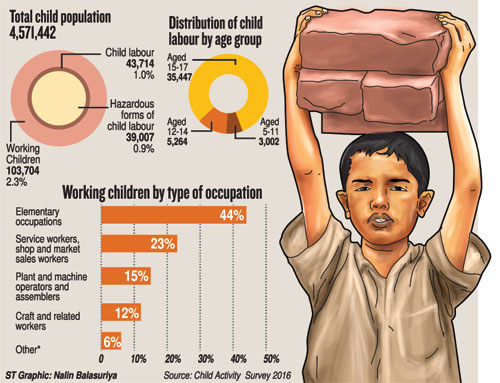News
Child labour: Kudos for Lanka, but 43,000 yet to be rescued
 Sri Lanka has made significant progress in eliminating child labour, but much needs to be done to rescue more than 43,000 children who are still being employed as cheap labour — most of them in ‘hazardous’ sectors, according to a countrywide survey report.
Sri Lanka has made significant progress in eliminating child labour, but much needs to be done to rescue more than 43,000 children who are still being employed as cheap labour — most of them in ‘hazardous’ sectors, according to a countrywide survey report.
It said that despite tough laws, child labour was being used in farming, herding, producing bricks, mining, carpet weaving, in quarries and construction sites. Compared to the 2008/2009 survey, the 2016 survey shows a 50 percent decrease in the number of children being used as child labour, highlighting the effectiveness of the measures the country has taken towards eliminating child labour.
The Employment of Women, Young Persons and Childrenâs Act No.47 of 1956 defines a âchildâ as âa person under the age of fourteen yearsâ. However, the 2016 Child Activity Survey (CAS) carried out by the Department of Census and Statistics regards all those who come within the age group of 5-17 as children.
According to the survey report , Sri Lanka has around 4.6 million children in the age group of 5-17. Of them, 43,714 were being used as child labour during the period covered by the survey, with some 39,000 working in sectors regarded as “hazardous”.
The Survey involves a countrywide representative sample of 25,000 housing units distributed across all 25 districts. It also covers Urban, Rural and Estate sectors as well as all types of households including one-person households.
The survey includes demographic characteristics, school attendance, economic activities, health and safety, housing, household characteristics and perception of parents/guardians on working children, and other characteristics pertaining to the children in the 5-17 age group.
The Labour Department’s Women and Children Division Commissioner, Padamanathan Mahadevan, said it was disheartening to see tens of children were still being robbed of their rights and childhood by those who were forcing them into employment.
Citing a UNESCO report, he said if children were sent to school, every additional year of schooling would increase their average future earnings by 10 percent, besides boosting the countryâs average annual GDP growth by 0.37 percent.
Mr. Mahadevan said education of children was a major factor on which the present and future social and economic development of the country depended.
He said his department acted promptly on complaints about child labour. âWhen we get complaints to our hotline 1929, we immediately start an investigation. We also act on complaints sent to us via post or made to the Police Emergency line 119.”
Commenting on children being employed in dangerous jobs, he said his division had identified 51 types of hazardous jobs under five categories — fisheries, tourism, plantations, quarries and sand mining.
The Commissioner said girls were largely employed as maids in houses in Colombo suburbs, while boys mainly worked in garages, boutiques and places where there was a lot of hard work to be done.
The Census Department survey estimates that 90.1 percent of Sri Lanka’s children were attending school. Among the children not-attending school, a majority (84.2 per cent) were in the 15-17 age group and about half of them were awaiting G.C.E (O/L) results. Around 6.8 percent of the child population are below the age of 5 years by January 2016.
The survey also highlights that of the children who were being employed, 41 percent work for their own families and 13.6 percent in shops, markets and boutiques.
More boys than girls are being used in hazardous forms of child labour, the survey shows. Some 1.3% of the total male child population is reported to be engaged in hazardous forms of child labour.
The survey report says only about 2.3 percent of children aged 5-17 years are engaged in some kind of economic activity (working). This is a decline of 10.6 percentage points when compared to the 2008/09 figures.
However, only about one percent of total child population were being used in child labour with 0.9 percent doing hazardous forms of child labour.
Poverty is the main cause of child labour in the rural and agriculture sector. Limited access to quality education, inadequate agricultural technology and the shortage of adult labour and traditional attitudes towards childrenâs participation in agricultural activities are some of the other factors that contribute to child labour.
Parents say they are forced to send their children to work because they could hardly make ends meet.
International Labour Organisation Country Director Donglin Li said that focusing only on banning child labour without taking the livelihood options of poor families into account would not solve the prevalent problems of child labour.
The tough implementation of the law and creating more awareness among the general people could be the answer to combat child labour, activists say.
The proposal by the Labour Ministry to adopt and implement the national policy aimed at the elimination of child labour in Sri Lanka has been approved by the Cabinet of Ministers, according to an official.
Sri Lanka agreed to eliminate child labour at the 2010 Global Child Labour Conference in the Hague.
The national policy on elimination of child labour in Sri Lanka is also one of the conditions the European Union has imposed to restore the GSP Plus trade concessions.

